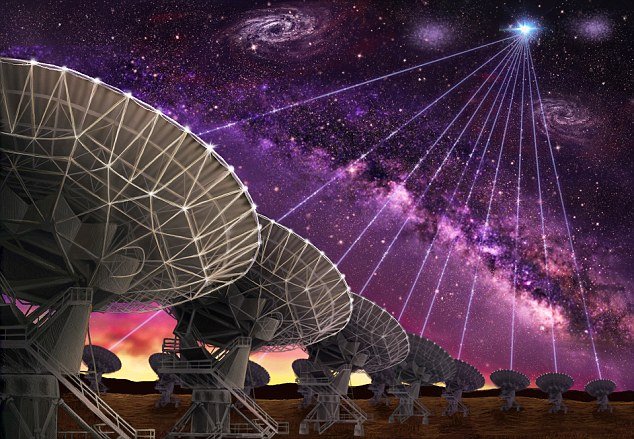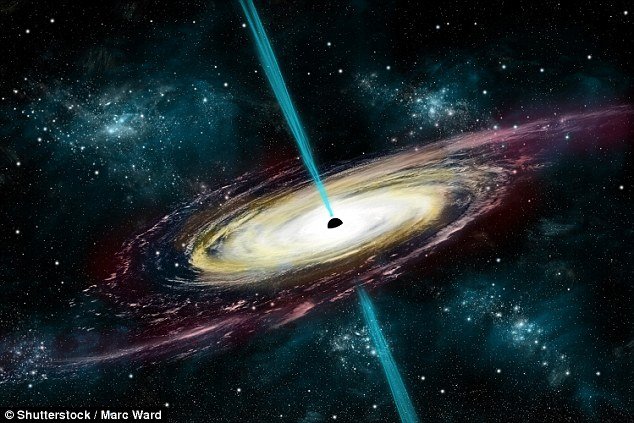Rare and brief bursts of cosmic radio waves have puzzled astronomers since they were first detected nearly 10 years ago.
Some suggested these mysterious bursts of energy could be a sign of alien life trying to contact us.
Now the signals have finally been tied to a source - a dwarf galaxy more than 3 billion light years from Earth.

Fast radio bursts, or FRBs, were first 'heard' by radio telescopes back in 2007.
The signal was so temporary and seemingly random that it took years for astronomers to agree it was not a glitch in one of the telescope's instruments, and none of those first observed were ever seen again.
A repeating burst discovered in 2012, however, provided the opportunity for a team of researchers from the University of California, Berkeley and Cornell University to repeatedly monitor its area of the sky.
'We now know that this particular burst comes from a dwarf galaxy more than three billion light-years from Earth,' said Shami Chatterjee, of Cornell University.
'That simple fact is a huge advance in our understanding of these events,' he added.
The team used the Karl Jansky Very Large Array in New Mexico and the Arecibo radio dish in Puerto Rico, in hopes of pinpointing its location.
'For a long time, we came up empty, then got a string of bursts that gave us exactly what we needed,' said Casey Law, from the University of California at Berkeley.
Using new software, the VLA last year detected a total of nine bursts over a period of a month, which was enough to pinpoint its location in the sky.
Further analysis by other telescopes allowed its location to be narrowed down.
'The VLA data allowed us to narrow down the position very accurately,' said Sarah Burke-Spolaor, of the National Radio Astronomy Observatory (NRAO) and West Virginia University.

he discovery that the bursts come from such a long distance away rules out any source in our own galaxy.
Before we knew the distance to any FRBs, several proposed explanations for their origins said they could be coming from within or near our own Milky Way Galaxy,' said Shriharsh Tendulkar, of McGill University in Montreal, Canada.
'We now have ruled out those explanations, at least for this FRB.'
But exactly what is causing the bursts in the dwarf galaxy is still not known.
Extremely bright exploding stars, called superluminous supernovae, and long gamma ray bursts also occur in the type of galaxy discovered in the new paper.
Both are hypothesized to be associated with massive, highly magnetic and rapidly rotating neutron stars called magnetars.
'All these threads point to the idea that in this environment, something generates these magnetars,' Law said.
'It could be created by a superluminous supernova or a long gamma ray burst, and then later on, as it evolves and its rotation slows down a bit, it produces these fast radio bursts as well as continuous radio emission powered by that spindown.

'Later on in life, it looks like the magnetars we see in our galaxy, which have extremely strong magnetic fields but rotate more like ordinary pulsars.'
In that interpretation, he said, fast radio bursts are like the tantrums of a toddler.
'We are the first to show that this is a cosmological phenomenon. It's not something in our backyard. And we are the first to see where this thing is happening, in this little galaxy, which I think is a surprise,' Law said.
'Now our objective is to figure out why that happens.'
Law says his favourite hypothesis about the origin of fast radio bursts is a magnetar surrounded by either material ejected by a supernova explosion or material ejected by a resulting pulsar.
But there are other possibilities.
One alternative is the galaxy's active nucleus, with radio emission coming from jets of material emitted from the region surrounding a supermassive black hole.
The source of the fast radio burst is within 100 light years of the continuous radio emissions from the core of the galaxy, which means they are the same or physically associated with one another.
'Finding the host galaxy of this FRB, and its distance, is a big step forward, but we still have much more to do before we fully understand what these things are,' Chatterjee said.
'Even without a clear answer, the authors' finding is a real game-changer, and the hunt for FRBs is afoot,' said Professor Heino Falcke, from the Radboud University Nijmegen who was not involved in the study, in an accompanying Nature News & Views article.
Thanks for reading this! I will hopefully have an AOW review up tomorrow, but today I decided to take a break and do research on a topic completely different than my usual topics. As always, feedback is appreciated, and remember to check back later!
Hi! I am a robot. I just upvoted you!
I found similar content that readers might be interested in:
https://phys.org/news/2017-01-fast-radio-tied-distant-dwarf.html
ok
I think the message is "Take me to your tender leader"
Fascinating stuff!
Thank you.
It's very interesting post :)
Exchellent job dear mahdi.ghamari !!I follow you now :D
Thank you so much.
It makes me happy.